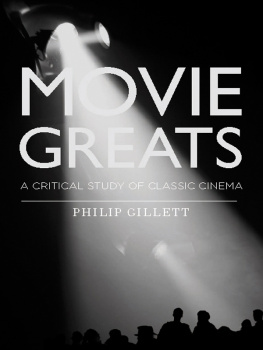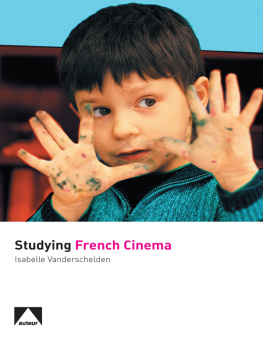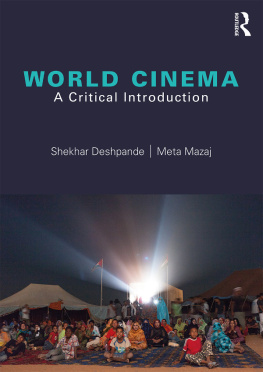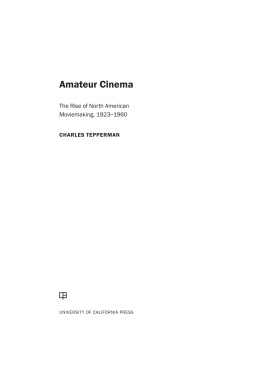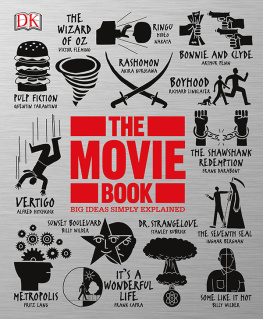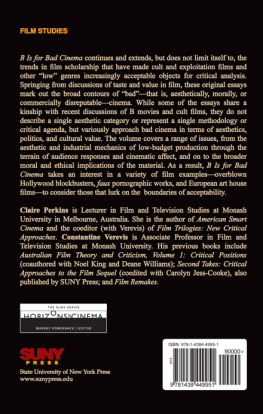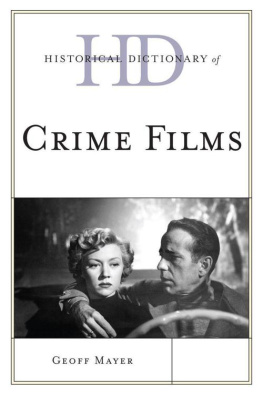Movie Greats
A Critical Study of Classic
Cinema
Philip Gillett

English edition
First published in 2008 by
Berg Editorial offices:
First Floor, Angel Court, 81 St Clements Street, Oxford OX4 1AW, UK 175 Fifth Avenue, New York, NY 10010, USA
Philip Gillett 2008
All rights reserved.
No part of this publication may be reproduced in any form or by any means without the written permission of Berg.
Berg is the imprint of Oxford International Publishers Ltd.
Library of Congress Cataloging-in-Publication Data
Gillett, Philip (Philip John) Movie greats : a critical study of classic cinema / Philip Gillett.
p. cm.
Includes bibliographical references
ISBN-13: 978-1-84520-652-9 (cloth)
ISBN-10: 1-84520-652-5 (cloth)
ISBN-13: 978-1-84520-653-6 (pbk.)
ISBN-10: 1-84520-653-3 (pbk.)
1. Motion pictures. I. Title.
PN1994.G533 2008
791.43dc22 2008027331
British Library Cataloguing-in-Publication Data
A catalogue record for this book is available from the British Library.
ISBN 978 1 84520 652 9 (Cloth)
978 1 84520 653 6 (Paper)
Typeset by Apex CoVantage
Printed in the United Kingdom by Biddles Ltd, Kings Lynn
www.bergpublishers.com
For Roz, with love
Contents
My thanks go to the library staff at Torbay, Bradford, Leeds, Manchester and the University of Exeter. They endured my pleas for help. Roz Ellis and Graham Derrick commented on early drafts. I am grateful to them and to Brian McFarlane and Keith Withall who readily answered my queries. Eric Fenwick identified scriptural references and Archie Montgomery gave me an insight into morality in nineteenth-century Scotland. Needless to say, any errors are mine. Particular thanks go to Tristan Palmer of Berg Publishers for his encouragement when this book was just a bright idea.
How do films achieve eminence? The question has troubled me ever since a friend admitted that he found Citizen Kane boring. My guilty secret was that I shared his feelings. This was sufficient reason for reappraising the film canon. Reputations once achieved are apt to be taken for granted even in academic circles. Who would admit that a work on every film students curriculum is unworthy of study?
A related issue is how we look at films. Film-makers know instinctively that emotions come first. As Ingmar Bergman put it: Both film and music bypass the intellect and assail the emotions. Both film and music are rhythm, breathingthat is what I have learnt. Film-makers seek to move audiences, eliciting tears, fear or laughter. Academics follow in their wake, assessing and justifying, with the emotional response relegated to being a shabby adjunct which does not easily fit within the critical apparatus. One consequence is a mismatch between what the public likes and what it should like. Horror films seem condemned to remain marginal despite their popularity. This phenomenon is not peculiar to film: crime novels and fantasy fiction have a reputation for failing to win major literary prizes. The arts are judged by status as much as quality.
This book seeks to reassess a selection of canonic films more subjectively than usual. Some proved popular with the public; others did not. The opening chapter looks at how greatness is assessed in the arts and the usefulness of concepts such as the sublime, myth, ambiguity and the collective unconscious in understanding the phenomenon. A more subjective approach is introduced which foregrounds the emotions. The second chapter examines the film canon and seeks to apply the subjective approach to film. Each of the following fourteen chapters focuses on a film which has garnered critical adulation and which disappoints me, the final two being speculative entrants to the canon. Accolades can drown out dissenting voices, but the number of heretics is surprising. It is reassuring not to be in a minority of one. The final chapter returns to the question of how some films achieve prestige at the expense of others and the implications this has for our culture.
Credits are transcribed from the films, supplemented by information from the International Movie Database (IMDb) ( http://imdb.com), the British Film Institutes (BFI) Film and TV Database ( http://www.bfi.org.uk/filmtvinfo/ftvdb), Film Reference ( http://www.filmreference.com) and AGP ( http://www.agpfilms.com/defaut.asp). Names become anglicized or shortened, so spellings may vary. Release dates are as given in the IMDb. Useful sources not cited in the notes are listed as further reading. These fall into three categories: neglected works, seminal works applicable to my approach and relevant new material. Extensive use is made of internet sources. Quality is variable, but this applies to any medium. Changes in URLs pose a difficulty, but the information provided should allow works to be located using a search engine.
1
So Who Says Its Great?
Three Models of Greatness
For those who consider themselves open to new ideas, I know what I like, with its implications of narrow-mindedness and inflexibility, is not a remark which springs readily to the lips. Not that I dont know what I like is any better, with its tacit admission of an inability to discriminate. The acceptable response lies somewhere between these extremes, assuming the whiff of compromise can be negotiated.
We might keep quiet about what we like, but there is no shortage of voices eager to fill the silence. The media abound with recommendations for what we should see, read and hear. And we take heed. Art lovers worship at the shrine of the MonaLisa. Musicians revere Bachs unaccompanied violin works and the operas of Mozart, just as lovers of literature venerate Cervantes and Proust. Most of us recognize the pinnacles of our culture, if only by repute. We may have no liking for them: of those who embark on reading Proust, how many reach the final page? And who would admit to preferring Stephen King?
Just as recommendations are plentiful, so are study guides and critical analyses which help us to appreciate the works of Beethoven, Conrad, Ibsen, Turner, and so on. It is axiomatic that these figures are great. A consistent if partisan concern with how such judgements are made has troubled art critics from John Ruskin onwards. This concern has not been matched in the other arts. Such neglect is unsurprising given the arcane processes involved in elevating a work to greatness, which make choosing a pope seem a model of transparency. Three ways of attempting to cast light on how greatness emerges are the market model, the consensus model and the time model. If none provides a sure route to greatness, at least the journey should encourage caution about applying labels.
The market model is precise but limited in its scope: CDs of Beethoven symphonies sell better than those of Havergal Brian; therefore Beethoven is the greater composer. This approach becomes problematic when Dan Brown is revealed as our greatest writer, with Agatha Christie taking the laurels in the longer term. Putting a monetary value on art means living with such anomalies, but at least it makes greatness quantifiable. The market model can be seen operating in its purest form when collectors bid for works of art. If Jackson Pollocks paintings command higher prices than those of Seurat, then Pollock is the greater painter. The snag is that when the public supports its preferences with cash, popularity becomes a term of disdain rather than a signifier of greatness. Reproductions of Constables paintings on tea towels have not enhanced his reputation, while Vladimir Tretchikoff and Jack Vetrianno remain beyond the critical pale despite their popularity, indicating how power is wielded in the art establishment. This tension between art and commerce has a long history. At the first Impressionist exhibition in 1874, Courbet rejected the usual practice of exhibits being chosen by judges in favour of asking artists to pay a modest fee. Was this a triumph for democracy or commerce? The music world is more democratic, or shows more commercial acumen, with figures such as Brian Eno and Frank Zappa probing the boundary zone between serious and popular music without losing their audiences. But playing classical music to deter teenagers from congregating in such semipublic places as shopping malls and railway stations should prompt speculation beyond the psychological mechanisms involved to the values of a society which uses art in this way.

